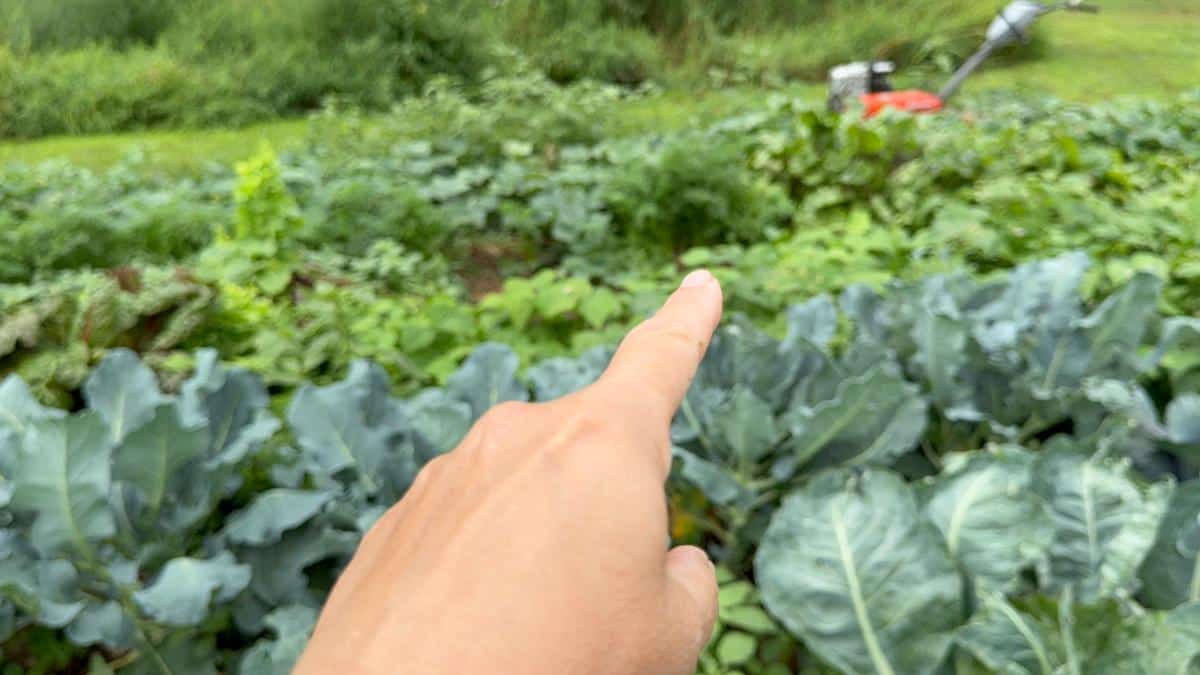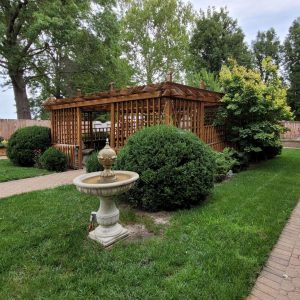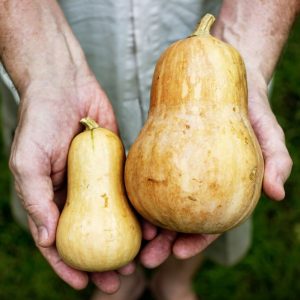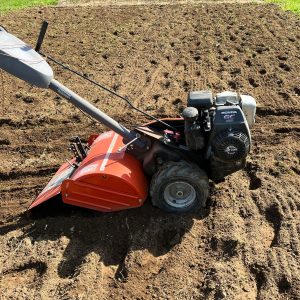How frustrating is weeding your garden and taking half your plants out with the weeds!?

It’s more than frustrating. It’s downright disheartening!
Jump to:
- 12 Tips to Weed Without Harming Garden Plants
- 1. Water before weeding
- 2. Start weeding early [in the season]
- 3. Follow the weed from the top down
- 4. Take time to get to know your weeds
- 5. Know your plants at different ages and stages
- 6. Grab weeds at the bottom of the stem
- 7. Pull to the side, adjacent to the ground, to pull away from the plant
- 8. If plants are crowded or difficult to pull to the side, pull straight up
- 9. Don’t grab large handfuls
- 10. Only use hoes and weeders in open areas where you’re sure you’re just weeding weeds
- 11. If necessary, give plants time to grow before attempting to weed
- 12. If in doubt, let weeds grow out
- Good Weeding Technique Comes with Garden Experience
12 Tips to Weed Without Harming Garden Plants
A lot of time, money, and effort go into growing a garden. So it’s not an easy thing to lose plants while trying to maintain your garden and help it grow.
Weeding experience will reveal the tips and tricks that will help you protect your plants while weeding. Or…you could just take this advice.
1. Water before weeding

Dry ground is hard ground. Hard ground clumps around plant roots and becomes almost like a rock when you pull them up.
The biggest problem with hard ground when weeding is that plants are hard to pull out. They tend to break, leaving the weedy root to live and grow another day.
Scuffle hoes and other tools are difficult to use because you can’t get them down into and through the hardened soil.
When the roots do pull out, they bring up a large clump of hard soil that often includes the roots of your nearby garden plants -- and the plant!
Moist soil is much easier to work with.
If you have not recently had rain and your soil is hard and compacted, water your garden before you try to weed it. That way, you will be able to pull the weed out and up or over, and not take your plants out with it.
2. Start weeding early [in the season]
Small weeds are easier to pull out. They also have smaller, less extensive root systems, so they don’t take everything else out with them.
The earlier you start weeding, the easier it will be to control the weeds. In itself, this can result in fewer weeds, which means less weeding and less potential for weeding out wanted plants.
Early, small weeding also makes it harder for good plants to hide amongst the weeds.
3. Follow the weed from the top down

Stems often look the same, or very similar, in both good garden plants and weeds. It is often the leaves and flowers, along with a lack of productive food being grown, that make it obvious that a plant is a weed.
When we are weeding, we are often lined up more to look at the stems than the whole plant. Look up. The difference will be more obvious this way.
Then, follow the plant from the top of the weed all the way down to the base just above the roots, and pull from there.
This will keep you from breaking the plant and will make sure that the stem you are pulling is really a weed stem, and not a look-alike garden plant that you intended to keep.
4. Take time to get to know your weeds
It may seem strange to want to know your weeds, but knowing the weeds that grow where you garden is the only way to tell the “good” from the “bad”.
The weeds that grow in a given area, though abundant, are also pretty standard stuff. Even if you don’t care to dive deep into their taxonomy, it would be worth identifying the major players so you know at a glance what a weed is that needs to go.
This can be especially helpful for early weeding and identifying weeds before your plants are obvious. Recognizing weeds at different stages lets you deal with them sooner.
5. Know your plants at different ages and stages

At the cotyledon or seedling stage, a lot of weeds and garden plants look identical. You will waste far fewer plants if you know not only what they look like at their grown, mature adult stages, but also what they look like as babies and juveniles. This way, you’re not accidentally misidentifying and weeding out valuable flowers, fruit, and vegetable plants.
It may take some time and experience, but make a point of trying to learn a little more about plant age and stage identification as you garden. It will set you up well for future successful weeding.
*A good way to get to know plants through their various stages is to start your own garden plants from seed. That way, you’ll see them as they germinate and emerge and as they grow into more identifiable mature plants.
6. Grab weeds at the bottom of the stem
Grabbing at the bottom of the weed stem lessens the chance of breaking the weed off and leaving the roots, which will then just regrow into a stronger weed. But it also stops you from accidentally grabbing a good plant stem in the middle and pulling out something that you wanted to keep.
7. Pull to the side, adjacent to the ground, to pull away from the plant

Pull weeds off to the side and out. This puts the weed at a different angle than your valuable garden plants, and will help ensure that the weed is the only plant that comes up while you weed.
This also helps to separate the weed from a group of plants and singles out only the plant you’re pulling.
8. If plants are crowded or difficult to pull to the side, pull straight up
If you can’t get a purchase to pull the weed out to the side, then pull one plant at a time and pull it straight up. If you can’t get to the bottom of the plant to pull from the base, grab some of the weed’s leaves.
Many gardeners don’t realize it, but the leaf attachment is stronger than the plant’s stems. Leaf attachments are one of the strongest parts of the plant. So by pulling attached leaves, you're more likely to lift the weed up and out than you are to break it off mid-stem.
9. Don’t grab large handfuls

This is one of the biggest mistakes gardeners make when weeding. We try to make better time, and we grab handfuls of weeds in an overgrown section instead of going after single identifiable weeds.
The problem is, good plant stems are often hiding in there.
If your garden is overgrown with weeds, you might be even more likely to pull out good plants. When these plants are crowded with weeds, they are starved for light, and they grow tall and leggy. They might not even resemble themselves much.
Long, lanky plants hide even more easily amongst weeds of similar sizes.
10. Only use hoes and weeders in open areas where you’re sure you’re just weeding weeds
There are some really excellent hoes and garden tools out there that help make quick time of weeding chores. But you need to be careful not to get ahead of yourself with them.
Use tillers, weeders, and scuffle hoes out in the open spaces where you can be sure there are no plants -- like in the aisles.
Slow down as you get closer to the plants. And if the plants have shallow roots, you need to weed that area by hand.
It’s worth knowing, though, that there are handheld versions of some of the large scuffle hoes and weeding tools. These can be a very nice compromise between hand weeding and overweeding with hoes and long-handled tools.
11. If necessary, give plants time to grow before attempting to weed

Though it’s best to get a jump on weeds and get rid of them in the small, young stage, if you can’t tell the difference between what’s a weedling and what’s a seedling, the weeding is going to have to wait.
This is especially true in confined garden spaces and with closely planted small vegetables or flowers. Many brassicas (like cabbage, broccoli, and cauliflower) can look almost identical to small weeds.
Flowers look especially close to weedlings; often, they’re closely related.
Things like carrots can look a lot like grass in their first stages. Instead of guessing and weeding them, wait until they grow into a more recognizable form.
12. If in doubt, let weeds grow out
The same is true for the weeds in your garden. If you weed too early, you may leave only weeds behind. Wait until there is an obvious and recognizable difference between plants and weeds.
Even if it makes more work in the long run, weeding when you can’t tell your plants apart is a bad idea. In fact, doing that is what might make even more work for you, because you’ll only end up having to replant what you weeded out.
Good Weeding Technique Comes with Garden Experience

There’s a lot that the work of weeding will teach you. It will teach you hacks, tips, and tricks, like these. It will teach you better, more plant protective techniques.
Every gardener has a mishap now and again. We’ve all weeded out some wonderful plants with big potential!
When that happens, learn from your mistakes. Find a new trick to help you along. And take your lessons back to the garden for a better result next time. Because with weeds -- you can always count on there being another chance at weed redemption!









Leave a Reply